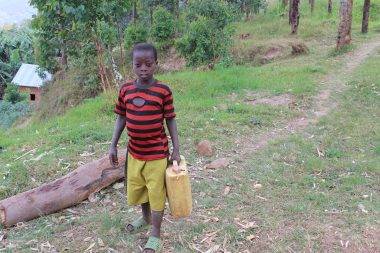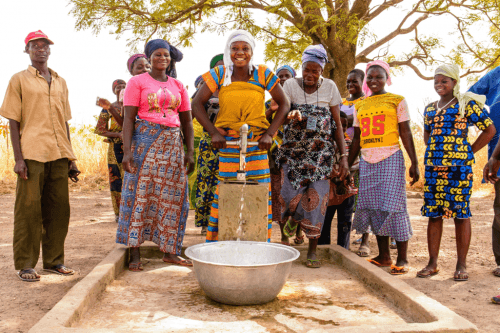This water station was built by/provided by the government. I learned from my Guide that 20% of the cost to visit the Mountain Gorillas is turned back to the community, mostly for creating infrastructure. Basically, this water station is a roofed brick structure, open at the sides. In the front were 3 spigots, which people would use to file their containers with water.
These water stations are way better than using the water from local streams. When I saw children filling up their water cans from the brown stream, I would cringe. I am not saying the water was polluted; it’s just the ground in this areas is volcanic soil and very fertile and must be boiled before drinking.
663 million people without access
When we talk about the word’s water crisis, today 663 million people on our planet do not have access to clean, safe drinking water. Every 21 seconds, a child dies from a water-related disease. The job of collecting water tends to fall on women and children between the ages of eight and 13. As a result, women are often unable to get jobs or contribute financially to their households. Children are often unable to go to school or get an education due to the thousands of hours they have to spend annually just hauling water.
There are many private initiatives that have been created as a response to the scarcity of water. In this article, I will talk about three: using solar panels to power a well; harvesting fog and installing hand pump freshwater wells.
Harnessing Solar Power to Pump Water in Africa
Innovation Africa installs solar, water and irrigation systems in poor villages in Uganda, Malawi, Tanzania, Ethiopia, the Democratic Republic of Congo, South Africa, Senegal and Cameroon.
Africa installs solar, water and irrigation systems in poor villages in Uganda, Malawi, Tanzania, Ethiopia, the Democratic Republic of Congo, South Africa, Senegal and Cameroon.
Sivan Yaari, founder and chief executive of an Israeli charity, was drawn to this effort after seeing children during a visit to drought-stricken Africa over 10 years ago. She saw people living in total poverty. Children weren’t able to go to school. Former farmlands were dust due to scarcity of water. There was no hope.
“Africa is still in poverty because of the lack of energy” said Sivan. “And because there is no energy, people are still searching for water, because there is no energy to pump water.
Many children don’t attend school. Lack of food and – more important – water, had rendered them “too weak to walk”.
People were weak and unhealthy because the water was making them sick. There is water in Africa in the aquifers. What people need is energy to pump it up.
By bringing in and installing solar panels, Innovation Africa was able to not only pump water in a village so villagers did not have to walk for miles to get water…but by adding drip irrigation, they can grow food with it.
Said Yaari. “No more famine. Just by bringing them water, we changed the village.”
Innovation Africa has installed solar technology in more than 170 African villages. For businesses interested in sponsoring a well in rural Africa, it costs about $25,000 to bring both power and water into a village. This may not be the solution to the world’s water crisis, but it is a start.
Fog Harvesting in Morocco
Scarce water, compromised wells, and climate change-induced droughts have destabilized traditional Amazigh communities in Morocco.
Rural poor families in Aït Baamrane live in ecologically fragile zones where water is scarce. This region is only 20 miles from the Sahara Desert. It receives just about five and a half inches of rain a year — barely 10 percent of the global average.
Women and children were devoting 3.5 hours daily to the chore of fetching water. This kept children from attending school. The lack of rainfall water was a major concern for survival especially during the dry season, not only for humans, but for livestock. People who could, moved to cities; farming stopped and traditional culture suffered.
An organization called Dar Si Hmad researched the possibility that fog would provide a source of water to support this region. The area boasts an average of 143 foggy days a year in the nearby mountains.
At the top of nearby Mount Boutmezguida, Dar Si Hmad has installed 15 honeycomb-shaped nets that have the capabilities of turning fog into as much as 5,000 of gallons of water a day. This is enough to service all the local villagers, whose average use is just under seven gallons of water a day.
The Cloudfisher

Rebecca Rosman, a journalist from Paris reported on a German technology called Cloudfisher. These are the nets installed at the top of Mount Boutmezguida. These nets captures fog as it rolls off the Atlantic Ocean and can harvest thousands of gallons of water from the sky on foggy days and withstand winds of up to 75 miles an hour. Droplets condense on the nets and then fall into a basin and then through a filtration system before descending through pipes to the surrounding villages.
Now, all 1,200 villagers living there have access to safe drinking water. Village traditions are coming back; children are able to attend school; farmers can farm and the area is stable and secure.
Is this a global solution to the world’s water crisis?
Around 40 percent of the world’s population faces water shortages. That includes some two billion without safe drinking water and over 4.5 billion living without proper sanitation.
The fog harvesting process can only work in certain parts of the world. First, there has to be a mountain range. And second, there needs to be a nearby body of water. This particular area, Ait Bamraane, had both.
While fog harvesting isn’t a solution that can work everywhere, similar projects are underway in the mountainous regions of Yemen, Chile, Mexico and South Africa.
Installing Hand Pumps in El Salvador for Freshwater Wells
El Salvador has a population of 6.29 million people, is located on the Pacific coast between Guatemala & Honduras and is the smallest and most densely populated country in Central America. The life expectancy is 72 years and the mortality rate of children under age five is 16/1000. The average annual income (GNI) per capita is $3,580.00 USD.
El Salvador has the second-highest number of homicides in the world, registering 69.2 violent deaths per 100,000 people.
40% of the population in El Salvador is made up of children, and 50% of the people live in extreme poverty
More than 25% of children under age five suffer from chronic malnutrition.
The Thirst Project is currently working in five countries, including El Salvador. Their goal is to provide access to a clean, safe water supply. This will enable children to go to school, women to have a job and allow farmers to develop sustainable agriculture production for food security. This can break the cycle of poverty.
The Thirst Project preferred method of implementing in the field is to build hand pumped freshwater wells. After they install the well, they undertake a program to train community members to maintain and repair these projects themselves for decades to come. According to the people at The Thirst Project, these wells should last 40+ years.
For $12,000, a Dealership can fund a well and change a whole village forever, giving women hope, children health, and the entire community a future!
Impact is a 2 way Street
We feel good about ourselves when we make an impact helping people. We also know that consumers place tremendous importance on the causes a brand supports. The world’s water crisis resonates with many consumers.
Studies continue to show that millennials and boomers prefer to do business with companies because of their ethics and social commitment.
This is an opportunity for a Dealership to become bigger than themselves by reaching outwards. Consumers look favorably on those dealership who are branded as investing in solutions to the world’s water crisis.
Reprinted from Water Conditioning & Purification Magazine, October 2019 issue



 Africa installs solar, water and irrigation systems in poor villages in Uganda, Malawi, Tanzania, Ethiopia, the Democratic Republic of Congo, South Africa, Senegal and Cameroon.
Africa installs solar, water and irrigation systems in poor villages in Uganda, Malawi, Tanzania, Ethiopia, the Democratic Republic of Congo, South Africa, Senegal and Cameroon.